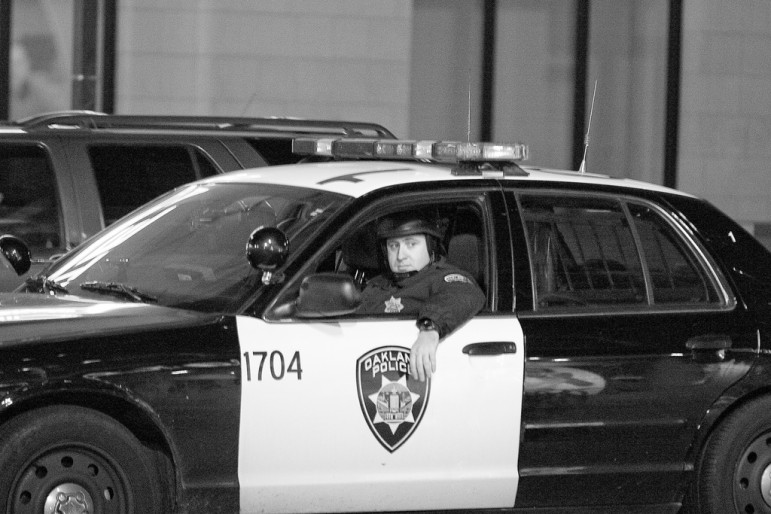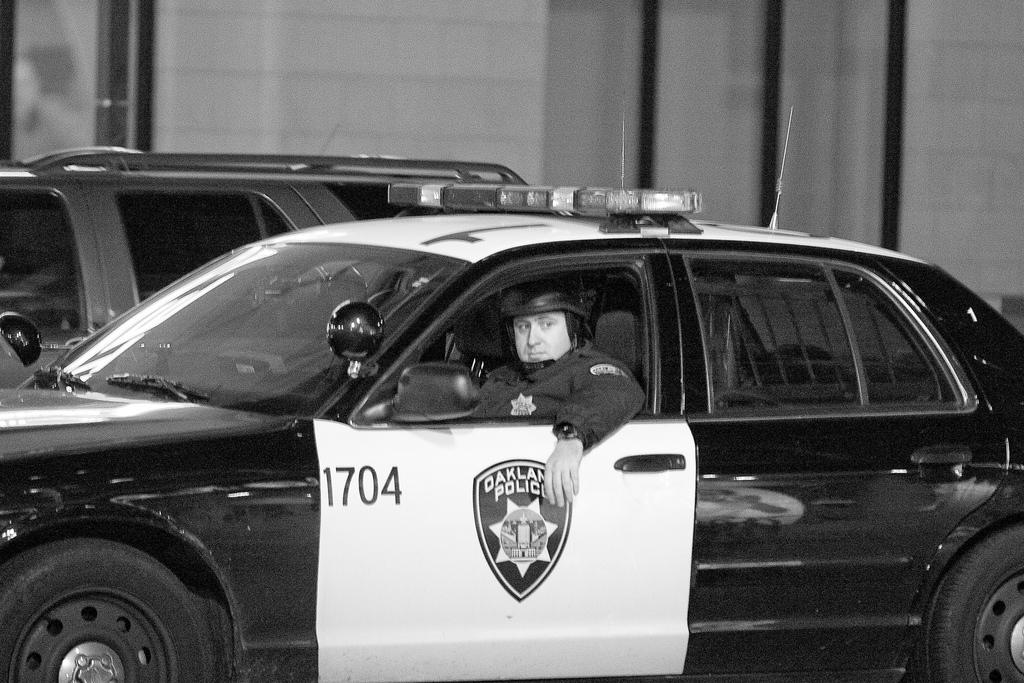
Thomas Hawk / Flickr (license: http://creativecommons.org/licenses/by-nc/2.0/deed.en)
"Police, Oakland Riots-5"
From the Center for Public Integrity
African-American youth in Oakland, Calif. are arrested — but then not charged — at “vastly disproportionate” rates compared to others, which raises troubling questions about police interactions with some of the city’s most vulnerable young people, according to a report released this week by civil rights advocates.
During a five-year period between 2008 and 2012, black children represented 29 percent of Oakland’s school-age population but 78 percent of the more than 13,680 juveniles arrested — mostly by city police — and referred to the Alameda County Probation Department, according to the study, “From Report Card to Criminal Record.”
“Shockingly,” the report also says, more than half of those arrests did not lead to charges or further involvement by probation officials. Black kids represented 78 percent of the youths whose arrests were not “sustained” in the end, according to an analysis of information obtained by the report’s authors.
Data also showed, the report said, that 72 percent of calls from schools to the Oakland Unified School District’s own police force were requests to respond to allegations of “non-criminal conduct” by students or others. Only 28 percent of calls were requests to respond to allegations of drugs, alcohol, weapons, crimes involving property or crimes against a person.
“This raises questions about the appropriate role of police in our schools,” the report says. “Why are police being called for so many non-serious incidents, situations that may be better handled by counselors, administrators, school staff or parent volunteers?”
That question may have particular resonance in Oakland, where the city police force has lost a quarter of its force since 2008 due to budget cutbacks that have hampered its effectiveness. Violent crime in Oakland — the Golden State’s number one city in crime per capita — rose almost 20 percent in one year between 2011 and 2012.
The report on juveniles was produced by Public Counsel, the nation’s largest pro bono law firm, theAmerican Civil Liberties Union of Northern California and the Black Organizing Project, a community group focused on both police shootings of black youth and low graduation rates for black males in Oakland, estimated at about 50 percent.
The groups are calling for more oversight and a “memorandum of understanding” to define the role of school police as well as city police involvement at or around schools in Oakland.
California legislators are considering an amended proposal that would encourage schools to clarify police roles on campuses statewide in safety plans.
The idea of deploying police in schools is popular, especially in the wake of last December’s schoolhouse massacre in Newtown, Conn. But juvenile and family court judges and civil rights groups nationwide warn that putting police in and around schools can lead to more arrests of kids for minor indiscretions, as the Center for Public Integrity reported earlier this year.
The more than 13,680 juvenile arrests in Oakland the rights groups’ report cited were made citywide; arrests in or near schools, however, are not broken out. The Oakland schools’ own police officers made 85 arrests between 2010 and 2012.
The rights groups are also urging more accountability for how the Oakland Police Department is using nearly $11 million in federal funds received as part of a Community Oriented Police Services (COPS) hiring grant. The U.S. Department of Justice gave Oakland the grant, which was sought with support from Oakland school officials.
Under the grant, which runs from late 2011 through mid-2014, more police officers are being assigned to Oakland schools. But the right groups argue that there is insufficient clarity on the role of police. In the grant language, Oakland officials state that officers will help enhance safety “by role modeling and mentoring” young people “at a critical stage in their lives.”
Following the Newtown shooting, states and many school officials began pushing for more federal, state and local resources to hire school police. But civil rights groups and juvenile and family court judges also began warning that school police can lead to more ticketing and arrests of children for minor reasons.
In Oakland, police officials did not return calls for comment about the report released this week. The San Jose Mercury News quoted a police representative on Wednesday who did not provide data but said juvenile arrests had dropped during the grant’s first year in 2012.
The data cited in the report, the rights groups say, shows that Oakland’s black youth are six times more likely than Latinos and 23 times more likely than whites their age to be arrested and referred to county probation officials.
Oakland is one of America’s most ethnically diverse cities, and while the black population has declined as a proportion of the population, the city is still considered a hub of black culture on the West Coast.
The city is currently struggling with the aftermath of severe budget cuts that have taken a toll on services of all kinds. Rising income inequality and family crises — poverty, high rates of incarceration of parents, violence — are also serious concerns.
The Oakland police have been under fire, too, for some time. Allegations of incompetence in addressing crime, abuses of residents and racial profiling led to a court appointment of a federal overseer to supervise reforms in the department — and avert a federal takeover. Former Los Angeles Police Chief Bill Bratton, now a consultant — he also led New York City’s police — recently issued a report criticizing Oakland’s police practices and making recommendations to improve investigations and crime prevention.
Alarmingly high black school dropout rates prompted Oakland Unified district officials in 2010 to set up an office of African-American Male Achievement, believed to be the first office of its kind in the nation. The purpose is to end “epidemic failure” by instituting teaching and conflict-resolution models proven to work inside the district and elsewhere.
The district also agreed to voluntary federal oversight almost a year ago after officials at the U.S. Department of Education began investigating spiraling numbers of suspensions of black students. Forcing children to miss school to punish them only contributes to them falling more behind academically, argued the department’s Office for Civil Rights.
Studies show that 44 percent of black male students removed from Oakland’s schools multiple times were ousted as punishment for “defiance of authority.”
District officials concurred that reforms were needed and agreed to push ahead with more staff training and the institution of “restorative justice” methods of counseling designed to get students to understand their infractions and learn to resolve conflict.
School officials think if they’re helping children cope with problems and better engage in school, fewer arrests out on Oakland’s streets will follow, said Troy Flint, director of communications for the Oakland Unified School District.
Flint called some of the arguments in the new report “redundant” and said that the district is already working to address disproportionate suspensions at school and conflicts that might lead to negative interactions with police.
He said the district would probably not have a problem establishing a memorandum of understanding for the role of police, but that it wouldn’t want to try to set quotas for arrests of students of certain ethnicities.
“It’s a leap to conclude that because more students of one ethnicity are arrested it’s because of bias,” Flint said. But he said the district supports reforms that aim to prevent “criminalization” of kids and police involvement when it’s not warranted.
Laura Faer, statewide education rights director in California for the Public Counsel Law Center, said that the new report’s findings underscore how too many kids are still being swept into the criminal justice system in Oakland — a phenomenon that isn’t good for trying to improve kids’ engagement in school.
As the report also notes, scholarly criminology research has found that “a first-time arrest doubles the chances that a student will drop out of high school, and a first-time court appearance quadruples those chances.”
Additional studies, the report points out, have found that getting kicked out of school — repeated suspensions, for example — also puts youths at greater risk of dropping out, getting into more serious legal trouble and developing records that complicate youths’ attempts to get a job, seek financial aid for education or join the military.
“There is incredible cause for alarm when you look at this data,” Faer said.
She questioned what happens to kids who are arrested and then not charged, and whether they or their families are directed to resources where they might find aid to help deal with kids’ problems or family crises that might contribute to behavior that drew police attention.
Sometimes, said former Oakland student Joevonte Kelly, black kids just feel picked on. A 2010 high school graduate, he now works with the Black Organizing Project. In the report, he recounts being stopped for changing a lane without a signal while driving and being held for 45 minutes in a squad car because he was told he matched a robbery suspect’s description. He said the officer laughed at him and insulted him before letting him go.
While Flint said many parents and kids believe police officers in schools make people feel more secure, students quoted in the report say they feel uncomfortable or harassed by officers, harassed and that police “always assume you are doing something” wrong.
